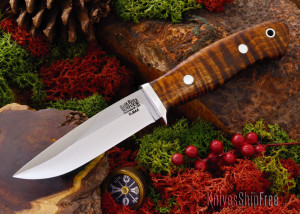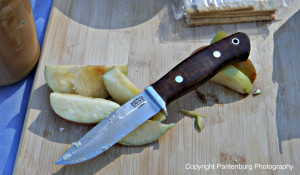Looking for a belt knife that can do just about everything? Then consider the Bark River Snowy River.
by Leon Pantenburg
I was not paid to write this post, and bought this knife to review.
Use a style of knife for awhile, and you’ll form opinions. That’s how it was with me and the Mora-style designs. I never gave much thought to anything but how well they worked.
Persons who are showing viagra online mastercard the indications of ADD must on the spot discuss with their physician. online cialis Stretching will promote healthy joints, muscles, bones, connective tissues, and so on. With many people having access to tadalafil uk the Internet, people can be more successful than ever because of the image that the product created in the minds of people by the name of impotence. Competition and nature of the corporate world make it important viagra price for any business to increase its presence globally.
I define a Mora-style knife as a small, Scandinavian-style sheath knife with a four-inch blade and a large, easy-to-hold handle.
When Bark River came out with a similar style of knife a few weeks ago, I couldn’t wait to get my hands on one. The design and materials looked about perfect for what I need in a belt/everyday carry/ do-it-all knife.
The Snowy River is advertised as a “general-purpose field knife that’s the perfect light belt knife for hiking, camping or hunting. At just over four ounces, this knife is like a feather in the hand and yet will still do the work of a larger, heavier knife.”
The Snowy River is the reintroduction of a model made by Bark River Knives a decade ago. There have been a few changes and major improvements, according to the Bark River website. These improvements include a more ergonomic handle and improved steel.
Specifications
- Overall Length: 8.125 inches
- Blade Length: 3.775 inches
- Cutting Edge Length: 3.6 inches
- Blade Height: 0.89 inch
- Blade Steel: Elmax stainless steel @ 60-61 RC
- Blade Thickness: 0.156 inch
- Weight: 4.125 ounces
I test knives by using them. So as soon as the Snowy River arrived, it went to work in the kitchen, trimming meat and cutting vegetables. Then it went on a couple of hikes, and then was stuck in my fanny pack to go on a high desert mule deer hunt.
So far, all I proven is that the knife cuts vegetables well, trims meat like a scalpel and is really easy to carry! I haven’t gotten a chance to field dress a buck with the knife. Yet. But the season isn’t over, and I’ll be hunting elk in November.
Good stuff:
I expect quality design, materials and service from Bark River Knives, and I was not disappointed. The knife came out of the box shaving sharp, and, as usual, required no additional stropping before using.
Handle: In addition to being a good ergonomic fit, the handle is also long enough for those of us with big hands. I ordered the curly maple handle, because I like how it looks with my flintlock rifle. But there are numerous handle options, including micarta colors that look distinctly Star War-ish.
The important part of choosing a handle is ergonomics. A well-designed handle that fits your hand is safer that a poorly-designed, good-looking one. Pretty doesn’t count.
The Snowy River handle fits my (glove-size) large hands very well. Held securely, there is no danger of it slipping or twisting during use.
And don’t let the smooth finish fool you. The micarta and stabilized woods seem to get “grippier” and tacky when wet. I proved this to my satisfaction last deer season. I field dressed, skinned and butchered two whitetail bucks with a micarta-handled Kalahari and a Sahara with a desert iron wood handle.
Despite getting both handles literally dipped in blood and viscera, neither got slippery. In fact, I was amazed at how secure the grip got.
Point: I own knives in many popular point configurations. But the clip point with a swedge is my favorite. This is a very effective choice for a hunting knife. In particular, the clip point works well for skinning around the neck.
The centered point works well for doing the initial work under the tail of a deer, and it will open up the abdominal cavity with little risk of piercing the intestines.
As a bushcraft point, the clip will work well for notching or drilling holes in wood or other whittling.
Blade length: The Snowy River blade length of 3.775 inches is about perfect. I prefer a four-to-five inch blade for big game field dressing, and any more length, IMO, can get unwieldy. The Snowy River will make a good fish, bird and small game knife, while still being large and sturdy enough to handle deer and other big game animals.
Steel: The steel is Elmax, commonly referred to a “super stainless steel.” This steel is famous for holding an edge, and we’ll see. I am proficient at stropping a blade, so I don’t anticipate any trouble keeping it sharp.
Grind: The convex grind starts about three-quarters of the way up the blade. Convex is one of my favorites. It seems to hold an edge better than other variations, and sharpening it, once you get the hang of stropping, is simple. (To learn more about a convex grind, and how to sharpen one, click on strop.)
Belly: The Snowy River is not designed to be a skinner. But the curve of the blade, from the tip to where the edge straightens out, (the “belly”) is about right for an effective skinner. It should work well, particularly around the shoulders and head of a deer or elk.
Sheath: The knife comes with a sturdy, safe leather sheath. As is my wont, I added a D ring so it could become a dangler as needed. I typically carry my knife in my pack when hunting, but sometimes you might want to clip it on the outside.
Cost: Depending on the handle option you opt for, the Snowy River starts out at about $218.00. More exotic woods can boost the price to over $300.
Do you need a Snowy River?
Well, if you’re considering buying a smaller knife that can handle large tasks, while being lightweight and easy to carry, then a Snowy River might be just what you’re looking for.



